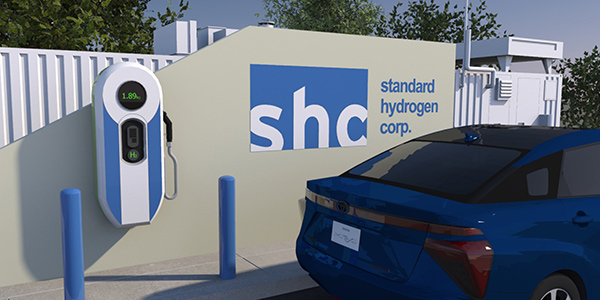National Grid is partnering with energy storage firm Standard Hydrogen to build a hydrogen energy station in New York that they say will be the first of its kind in the U.S.
As designed, the multiuse station would function as a refueling station for cars, while also using stored hydrogen to make electricity that can support peak demand on the power grid.
The renewable hydrogen storage and delivery station would support grid reliability if approved by state regulators, Paul Mutolo, co-founder and CEO of Standard Hydrogen, told NetZero Insider. It would also provide a non-pipes alternative to National Grid’s natural gas distribution system.
An electrolyzer would produce hydrogen at the site by splitting water molecules into hydrogen and oxygen that would be stored for later use. The hydrogen becomes a medium for long-duration electrical energy storage, or a renewable energy carrier that can be used to fill fuel cell vehicles without greenhouse gas emissions.
The system would produce and store hydrogen made with purchased solar and wind energy, and the stored energy would reduce reliance on oil and gas during peak grid demand in the winter.
“The grid doesn’t really have a great cushion,” Mutolo said. Hydrogen fills in the variability gap of wind and solar.
As electric and fuel cell vehicles increase, states will need to make significant charging infrastructure upgrades. The hydrogen energy station will give the grid flexibility to meet demand, Mutolo said.
It would have the capacity to eliminate 6,400 metric tons of carbon dioxide emissions and 740,000 gallons of gasoline demand annually, according to National Grid.
The utility set its goal of net-zero emissions by 2050. Hydrogen is key in leveraging the utility’s existing natural gas supply system to cut greenhouse gas emissions, Sheri Givens, the vice president of U.S. regulatory and customer strategy, told NetZero Insider. The renewable natural gas produced by the station will be injected into National Grid’s gas distribution system.
The utility is also partnering with Stony Brook University to research how hydrogen can be blended with natural gas, along with what the current natural gas distribution system in the Northeast can withstand, Givens said.
Hydrogen is not a new industry, so it already has a supply chain, Givens said. Renewable hydrogen has not been widely adopted because of the cost of electrolysis, but National Grid is investigating whether there are ways to lower the cost and make the renewable source of energy more affordable.
The utility is working with “all the tools in the toolbox” to meet its net-zero emissions goal by 2050, and “hydrogen is just one of them,” Givens said.
Standard Hydrogen will not bid the station into the NYISO market for the time being, Mutolo said. It is too small to meet ISO standards but Standard Hydrogen is “planning to build out more than this one unit.”
And the firm “plans to replicate this quickly” in other states in the Northeast, Mutolo said. Massachusetts has deployed more solar on the grid than New York, which means there is more opportunity for the storage and delivery system to help ISO-NE balance the grid.
The expected completion date for the New York station is late 2022.


